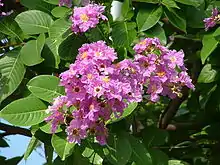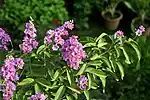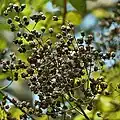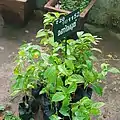| Lagerstroemia speciosa | |
|---|---|
 | |
| Flowers on a tree in Kolkata, West Bengal, India | |
| Scientific classification | |
| Kingdom: | Plantae |
| Clade: | Tracheophytes |
| Clade: | Angiosperms |
| Clade: | Eudicots |
| Clade: | Rosids |
| Order: | Myrtales |
| Family: | Lythraceae |
| Genus: | Lagerstroemia |
| Species: | L. speciosa |
| Binomial name | |
| Lagerstroemia speciosa | |
| Synonyms[1] | |
| |
Lagerstroemia speciosa (giant crepe-myrtle, Queen's crepe-myrtle, banabá plant, or pride of India, or "Queen's Flower" or "Jarul"[2][3]) is a species of Lagerstroemia native to tropical southern Asia. It is a deciduous tree with bright pink to light purple flowers.[4]
The name "Queen's Flower" is derived from the specific epithet 'reginae' or 'flosreginae', which means "imperial or flower of the queen". The tree bears beautiful attractive flowers in profusion in purple, lilac or pinkish-violet colours, and lasts for many months. Its timber is next only to teak in its strength.[2] It is called Queen Crape myrtle as its flowers look like delicate crape paper.
Etymology
The genus Lagerstroemia was first described by Carl Linnaeus. The name Lagerstroemia recognizes Magnus von Lagerstroem, a Swedish naturalist and a merchant who provided specimens from the East for Linnaeus.[2]
Names
The names in English and other languages are as under:[5]
- Assamese: এজাৰ (Ezar)
- Bengali: জারুল (Jarul) [5]
- English: Pride of India, Queen Crepe Myrtle.[5]
- Hindi: जरुल (Jarul)[5]
- Indonesian: Bungur
- Kannada: Hole dasavala
- Kapampangan: Banába
- Khmer: ត្របែកព្រៃ (Trobaek Prey)
- Malay: Bungor raya (بوڠور راي)
- Malayalam: മണിമരുത്,പൂമരുത്
- Marathi: ताम्हण (Tamhan), जारुळ (Jarul), मोठा बोंडारा [5](Motha Bondara)
- Tagalog: Banaba
- Tamil: கதலி (மலர் or Kadali)[5]
- Telugu: Manimaruthu [5]
- Thai: อินทนิล (Inthanin)
- Vietnamese: Bằng lăng nước
Growth
It is a small to medium-sized to large tree growing to 15 metres (49 ft) tall, with an attractive symmetrical crown having a short bole or trunk with smooth, flaky light grey or cream-coloured bark.[2] The leaves are simple, deciduous, oval to elliptic with stout petiole, 8–15 cm (3.1–5.9 in) long and 3–7 cm (1.2–2.8 in) broad, with an acute apex. The flowers are produced in erect panicles 20–40 cm (7.9–15.7 in) long, each flower with six white to purple petals 2–3.5 cm (0.79–1.38 in) long. It has simple leaves with, glabrous, large, elliptic or oblong lanceolate.[2]
The fruits are ellipsoid or sub-globose woody capsules. They are green at first, but later turn brown and finally black. The fruits hang on to the trees. It is easily raised through seeds. It grows best on rich deep alluvial loams and prefers warm, humid and moist soils and can withstand water logging.[2]
Flowering occurs 3–5 years after planting and the main flowering season is April–June with a second flush in July–August. The fruits ripen in November–January.[2] p. 198
Cultivation and uses
It is grown in South East Asia, China India, Bangladesh and the Philippines and even extends to Australia. It is native to India particularly in the western ghats of India covering Belgaum, north and south Kanara, Malabar and Travancore and also in Assam and West Bengal.[2] It is also widely cultivated as an ornamental plant in tropical and subtropical areas.The leaves of the banabá and other parts are used widely in the Philippines, Taiwan, and Japan as a tea preparation. Banabá herb is one of the 69 herbal plants promoted by the Philippine Department of Health (DOH).[6] In Vietnam, the plant's young leaves are consumed as vegetables, and its old leaves and mature fruit are used in traditional medicine for reducing glucose in blood.[7] The seeds have narcotic properties.[8]
Chemistry
Chemical compounds that have been isolated from the extract include corosolic acid, lager-stroemin, flosin B, and reginin A.[9]
Medicinal uses
Giant Crape Myrtle's seeds are narcotic, bark and leaves are purgative, roots are astringent, stimulant and febrifuge (fever removing). Decoction of leaves is used in diabetes. In Manipur, its fruit is used locally applied for apathy of the mouth [5]
Recognition
Pride of India or Tāmhan in Marathi is recognised as the state flower of the state of Maharashtra in India.[10]
In Hindu mythology, it is said that worshipping Lord Brahma results in blossoming of these flowers of Giant Crape Myrtle and Banaba tree and as such it brings prosperity to the house.[11]
In Buddhism
In Theravada Buddhism, this plant is said to have been used as the tree for achieving enlightenment, or Bodhi by the eleventh Buddha ("Paduma – පදුම"), and the twelfth Buddha (Naarada – නාරද)t. The plant is known as මුරුත (Murutha) in Sinhala and Mahaasona – මහාසොණ in Sanskrit.
Gallery
 Fruit, leaves & black drongo (Kolkata, West Bengal, India)
Fruit, leaves & black drongo (Kolkata, West Bengal, India) Flowers and leaves (Kolkata, West Bengal, India)
Flowers and leaves (Kolkata, West Bengal, India) Dried fruits (Kolkata, West Bengal, India)
Dried fruits (Kolkata, West Bengal, India) Dried fruits (Kolkata, West Bengal, India)
Dried fruits (Kolkata, West Bengal, India) Flowering small tree (Narsingdi, Bangladesh)
Flowering small tree (Narsingdi, Bangladesh).jpg.webp) Inflorescence close up (Camarines Sur, Philippines)
Inflorescence close up (Camarines Sur, Philippines)
References
- ↑ Lagerstroemia speciosa (L.) Pers. — The Plant List
- 1 2 3 4 5 6 7 8 Swaminathan, M.S.; Kochar, S.L. (2019). Major Flowering Trees of Tropical Gardens. Cambridge University Press. p. 197. ISBN 9781108481953.
- ↑ "Lagerstroemia speciosa (L.) Pers. pride of India." PLANTS Profile, United States Department of Agriculture / Natural Resources Conservation Service. Retrieved 2008-07-15.
- ↑ "Lagerstroemia speciosa (Giant Crape Myrtle, Queen's Crape Myrtle) | North Carolina Extension Gardener Plant Toolbox". plants.ces.ncsu.edu. Retrieved 2021-11-01.
- 1 2 3 4 5 6 7 8 Khatri, Vikas (2020). Herbal Cure – Medicinal Plants that heal naturally. V&S Publishers. p. 43. ISBN 9789350571842.
- ↑ Eduardo B. Principe and Aurora S. Jose (2002). "Propagation Management Of Herbal and Medicinal Plants" (PDF). Research Information Series On Ecosystems. Retrieved 25 January 2013.
- ↑ Tanaka, Yoshitaka; Van Ke, Nguyen (2007). Edible Wild Plants of Vietnam: The Bountiful Garden. Thailand: Orchid Press. p. 90. ISBN 978-9745240896.
- ↑ Hargreaves, Dorothy; Hargreaves, Bob (1970). Tropical Trees of the Pacific. Kailua, Hawaii: Hargreaves. p. 16.
- ↑ Klein, G.; Kim, J.; Himmeldirk, K.; Cao, Y.; Chen, X. (2007). "Antidiabetes and Anti-obesity Activity of Lagerstroemia speciosa". Evidence-Based Complementary and Alternative Medicine. 4 (4): 401–407. doi:10.1093/ecam/nem013. PMC 2176148. PMID 18227906.
- ↑ "Maharashtra State Symbols". www.onlinesaraswati.com. Retrieved 2019-10-17.
- ↑ Samantaray, Anamika (15 December 2020). "Health Benefits Of Queen Flower Plant!". StylEnrich.com.
- Huxley, A., ed. (1992). New RHS Dictionary of Gardening 3: 10.
.jpg.webp)